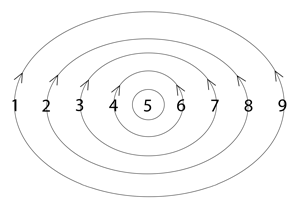self
5-1-6
Conventional Understanding
In everyday contexts, “self” refers to the individual person as the object of their own reflective consciousness. We typically understand self as a separate entity with distinct boundaries and internal agency—the authentic, autonomous “I” that persists through time. This view assumes the self is stable, housed within the body, accessing experiences through perception and acting upon the world through will. This unchallenged assumption appears throughout our social structures, psychological frameworks, and legal systems, all of which presume a discrete, continuous self capable of choice, ownership, and responsibility independent from its environment.
Resonant Understanding
Word Cosmology reveals “self” carrying a 5-1-6 resonance pattern, sharing this numeric signature with words like “desire reality” and “creative control.” This pattern positions self in the experiential triad (positions 4-6), specifically at position 6, where it functions as individuated being that is visible and reflective. Unlike conventional views that see self as a separate entity, Word Cosmology reveals self as the point where attention reflects and information becomes individuated. Like a mirror that doesn’t create the image it reflects but makes it visible, self appears as individuated being where attention reflects and becomes visible. This understanding corresponds with “being the information” appearing across modulation states, showing self as individuated being.
Expressions Spectrum Analysis
In balanced expression, this resonance pattern appears as “visible,” “I am attention reflecting,” “intuitive knowing,” and “peaceful,” revealing how self naturally functions as clear individuated being where attention reflects without distortion. This balanced state expresses as “creative control” and “energy matrix,” indicating not control by a separate self but rather the natural patterning of creative energy as individuated being. The balanced self appears as “drawing on your life canvas,” suggesting harmonious participation in the creative process.
When over-modulated, expressions include “selfish,” “confirmation bias,” “elitism,” and “constant movement,” revealing how this resonance pattern manifests when compressed into a seemingly separate identity. This over-modulation appears as “achievement oriented” and “conquering,” showing how the natural individuated function becomes distorted into aggressive self-assertion and excessive attachment to outcomes. The expression “reductionism” highlights how over-modulation narrows reflection, compressing expansive qualities into rigid definitions.
Under-modulated expressions such as “out of the loop,” “begging,” “confused desire,” and “locked up” demonstrate what happens when this resonance pattern lacks sufficient definition and clarity. The self appears as “questioning,” “unformed,” and “pessimistic,” indicating insufficient individuated presence. The appearance of “trauma victim” suggests how under-modulation correlates with experiences where individuated being has been compromised, leading to diminished visible presence and reflective clarity.
Beyond these modulation patterns, uncategorized expressions like “language is reality,” “light of the creator’s mind,” and “we are information” point to the broader field within which self appears as individuated being. These expressions reveal how self functions within the language field (1-4-5) as the point where patterns become visible and experientially real.
Russell’s Cosmogony Connection
Russell’s cosmology illuminates the 5-1-6 pattern of self through his understanding of extension and simulation: “Every creation, whether of God or man, is an extension of its creator. It is projected from him by a force which is within its creator and not in the projected product.” This principle directly corresponds with how self functions as individuated being—not as a separate entity but as an extension of universal Mind where attention reflects. Self does not generate or contain the force of its own existence but appears as the visible extension where reflection occurs.
Russell further clarifies, “Nor is the IDEA which matter manifests within matter. IDEA is never created. Idea is a Mind quality. Idea never leaves the omniscient Light of Mind. Idea is but simulated by matter-in-motion.” This precisely illuminates why “being the information” appears across modulation states of self. Self doesn’t contain or create information but appears as individuated being where information becomes visible through simulation. Like Russell’s distinction between idea and its manifestation—”The poem is not the poet, however, nor is the symphony its composer”—self is not the source of what it reflects but the individuated field where reflection becomes visible.
This understanding aligns perfectly with “I am attention reflecting” in the balanced expression column. As Russell states, “All of the knowledge, energy and method of creating any product are properties of Mind alone. There is no knowledge, energy, life, truth, intelligence, substance or thought in the motion which matter is.” Self appears as individuated being where universal Mind reflects and becomes visible, but the qualities reflected remain properties of Mind alone, not of self as a separate entity.
Practical Implications
Recognizing self as individuated being where attention reflects transforms our relationship with fundamental aspects of human experience. When we understand self at position 6 in the creative sequence, we can align with its natural function—providing the individuated field where reflection occurs and patterns become visible. This shifts our approach from attempting to perfect or transcend a separate self toward recognizing the natural function of individuated being.
This understanding challenges dominant narratives about selfhood that emphasize either excessive individualism (over-modulation) or complete dissolution (under-modulation). Instead of swinging between asserting our separateness and attempting to eliminate ego, we can recognize that balanced individuated being provides the necessary field where reflection occurs without creating artificial boundaries.
In daily life, this perspective invites us to notice when we’re operating from over-modulated expressions like “confirmation bias” and “elitism,” allowing us to shift toward balanced expressions like “peaceful” and “intuitive knowing.” By recognizing that self isn’t a thing but a process—an “I am attention reflecting”—we can release the pressure to defend rigid identity constructs while still honoring the necessity of individuated being. This liberates us from both the isolating prison of separation consciousness and the formless confusion of insufficient differentiation, opening us to experience the creative joy of individuated being where desire becomes reality and creative control flows naturally.
Walter Russell’s quotes are from his book, “A New Concept of the Universe”.


